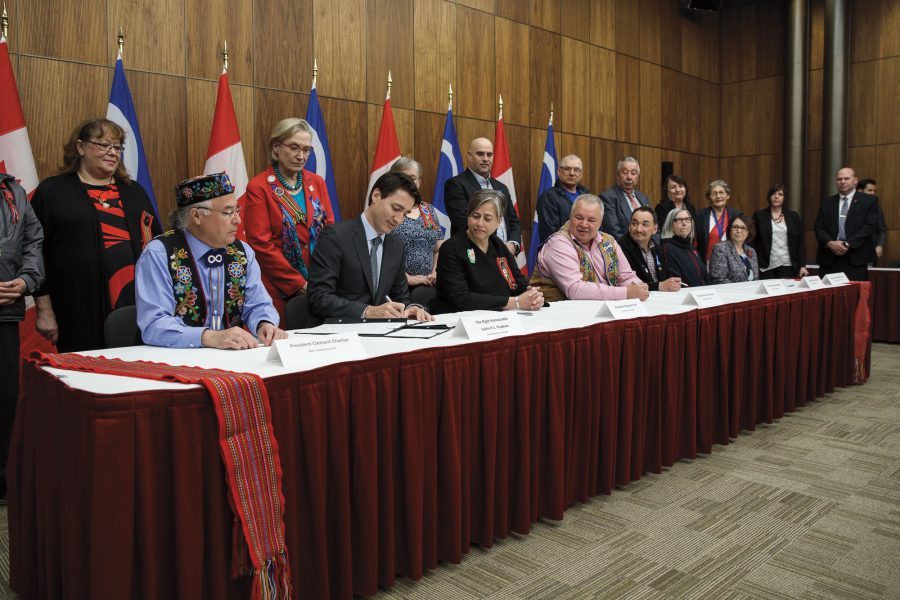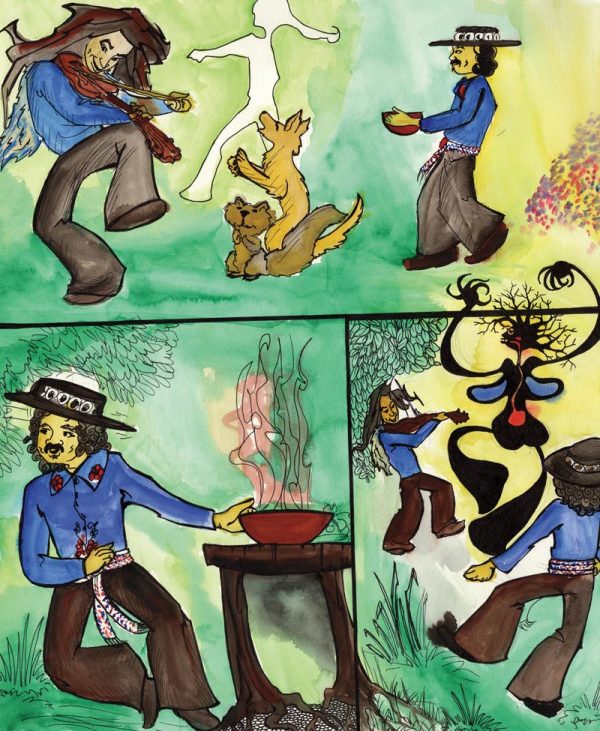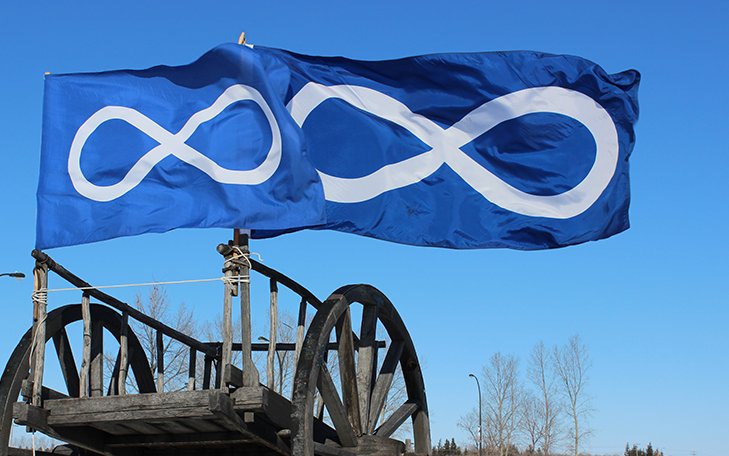November 16, 2021The Métis Nation  Canada's once forgotten people
|

Manitoba Métis Federation President David Chartrand and others celebrate a historic Supreme Court ruling extending rights to Métis and non-status Indians (Indigenous Peoples Atlas of Canada)
|
The Métis are a distinct Indigenous nation with a unique collective identity, culture, history, traditions and beliefs, with roots traced back to the Red River area of what is now Manitoba.
As the fur trade grew in the historic Northwest, the population of people with mixed Indigenous and European ancestry grew too. Distinct communities emerged, connected by the mobile fur trade network and collective identity in the context of relations with other Indigenous nations.
Demographic facts
- 587,545 Métis people self-identify in Canada, representing the fastest-growing Indigenous population in Canada (35% of the total population with 51% growth since 2006)
- The population increase is largely due to a rise in self-identified Métis and those discovering their heritage
- 22% of the population are 14 or younger—over twice the proportion of those 65 and older (9%)
- Most Métis people live in Ontario and the western provinces, and with 6 in 10 Métis people living in medium- to large-sized cities, they are the most metropolitan Indigenous group in Canada
- A third of the entire Métis population lives in Winnipeg, Edmonton, Calgary, Ottawa-Gatineau, Montréal, Toronto and Saskatoon
Source: 2016 Census (Statistics Canada)
Join our first ever online symposium on Indigenous economiesNovember 29-30 from 13:45 to 19:00 ET | North America
November 30-December 1 from 07:45 to 13:00 NZDT | South Pacific
|
Métis history
Major events including the Battle of Seven Oaks, the Red River Resistance and the establishment of the National Committee of the Red River Métis led to the emergence of Métis as a distinct Indigenous nation.
In the years since, Métis people have fought to protect their rights and existence as Indigenous peoples.
Louis Riel and the Red River Resistance
During the Red River Resistance of 1869-70, the Métis formed a provisional government led by Louis Riel to defend their rights as Manitoba negotiated entry into Confederation.
The resistance began as a response to the largest land sale in history when the Hudson’s Bay Company (HBC) sold Rupert’s Land to the Dominion of Canada without first consulting the Indigenous peoples who lived there. The Métis felt that HBC did not possess the right to sell the territory without its consultation or consent. Led by Riel, fearing for their culture and land, they mounted a resistance.
On November 16, 1885, 136 years ago today, Louis Riel was hanged after being found guilty of high treason. This day is significant for Métis across Canada to reflect on Louis Riel’s legacy and the values he died defending.
For more information on Métis history, you can visit the Indigenous Peoples Atlas of Canada.
Identity, recognition and representation
|

Prime Minister Justin Trudeau and Métis Nation President Clément Chartier meet in Ottawa in April 2017, when the Canada-Métis Nation Accord was signed (Indigenous Peoples Atlas of Canada)
|
Organizations representing Métis people are currently grappling with the challenge of identity, specifically the growing use of self-identification as the sole method for evaluating claims of Métis identity absent genealogical connections or community recognition and acceptance.
In recent months, disagreements on citizenship policies and self-identification has led to fractures within Métis organizations and the exit of the Manitoba Métis Federation from the Métis National Council, meaning two organizations now represent Métis at the national level.
In 2019, the Métis Nation of Alberta (MNA), Métis Nation of Ontario (MNO), and Métis Nation-Saskatchewan (MN-S) signed historic self-government agreements with the Government of Canada acknowledging their right to self-government. In 2021, the Manitoba Métis Federation was officially recognized as the democratically elected government of the Manitoba Métis.
Both agreements are significant and are the result of decades of work by the Métis people to gain recognition and self-government rights from the federal government.
Sources: Identity (Indigenous Peoples Atlas of Canada), Métis (The Canadian Encyclopedia), Exploring Identity: Who are the Métis and what are their rights? (CBC)
Oral Tradition and creation stories
|

The story of the trickster illustrated by Carrie Saganace, from her graphic novel Stories of Our People (Indigenous Peoples Atlas of Canada)
|
The Métis, like other Indigenous groups, pass their histories, legends and family remembrances down through the Oral Tradition.
Blending traditions
Métis stories blend Cree, Ojibwa and French-Canadian traditions. These different spheres have been fused into one Métis storytelling tradition. However, while Métis stories clearly derive from these traditions, they have different meanings, they have evolved to meet Métis needs, and they express a distinct Métis worldview.
Trickster stories
Traditional Métis stories include narratives about malevolent spirits that transgress against the Creator and society, as well as trickster-based creation or morality stories. Trickster stories are often humorous. These are generally creation stories and closely follow the oral narratives in the Cree and Ojibwa languages.
The Métis tricksters — Wiisakaychak, Nanabush, and Chi-Jean — are essentially good characters who have very human foibles, including gluttony and selfishness. They serve as the Creator’s intermediaries to humans, and their adventures explain the workings of the natural environment.
Read a Métis story
Excerpts from: Métis Oral Traditions (Indigenous Peoples Atlas of Canada)
The Métis economy
Ongoing systemic barriers and gaps in economic outcomes between Indigenous and non-Indigenous Canadians continue to have an impact on Métis people.
Economic indicators for Métis people
Compared to First Nations and Inuit, Métis people have a higher employment rate, with rates close to the non-Indigenous rate. According to the 2016 census, the overall employment rate among Métis people decreased from 63.1% in 2006 to 60.3% in 2016; however, this decrease was similar to the non-Indigenous employment rate over the same time.
According to a report by the National Indigenous Economic Development Board (NIEDB), while the changes were similar the effects were amplified for Métis communities. Excerpt from the report (page 31): "This demonstrates an increased vulnerability to job market fluctuations that will need to be addressed to close the gap between Indigenous and non-Indigenous Canadians."
Other indicators including completion of post-secondary education and incomes are higher than for other Indigenous groups, but are generally lower than the non-Indigenous population.
Read more: First Nations People, Métis and Inuit in Canada: Diverse and Growing Populations (Statistics Canada)
Discover something new from Métis art and culture
Explore Métis art, music, and some of the cultural symbols that make the Métis people distinct.
Have a favorite Indigenous artist or recipe? Let us know! Reply to this message and we will share it on the conference website for others to discover.
The Métis sash
One of the most prominent symbol of the Métis Nation is the brightly coloured, woven sash which symbolizes pride and identification for Métis people. The Metis sash is featured on the Canada 150 bank note that was issued in 2017.
The Métis flag
According to the Métis Nation of Ontario, the infinity symbol depicted on the Métis flag represents the immortality of the nation, in the centre of a blue field represents the joining of two cultures.
|

The first recorded use of the Métis Nation flag was in 1816 (Tweet from the Manitoba Métis Federation)
|
Fiddle music and jigging
The fiddle has been the prominent instrument of the Métis people for hundreds of years. It accompanies the jig dance. The Red River Jig is a famous piece of Métis music originating in the Red River.
Michif language
Métis people have traditionally been multilingual, reflecting their ongoing connections with other Indigenous nations and European communities, both anglophone and francophone.
Michif is one of the most important languages of the Métis people, orignating in the Red River. It was once spoken across the homeland, but like most Indigenous languages the number of Michif speakers declined due to colonization.
The Métis Nation of British Columbia’s LearnMichif is an example of several programs designed to help families keep their traditional language alive.
Métis Minutes
Discover more about Métis arts and culture through the Manitoba Métis Federation’s Métis Minutes.
About our Emcee: John Lagimodiere
The Bank of Canada is proud to announce that John Lagimodiere will be the emcee for the upcoming symposium.
John is a proud member of the Métis Nation, champion of Indigenous Peoples in Canada and a descendent of Marie Anne Lagimodiere, who was the first white woman to settle in Western Canada and was grandmother to Canadian Métis hero, Louis Riel.
 |
John Lagimodiere
Learn more (International Indigenous Speakers Bureau) |
Acknowledgements
We acknowledge that the Bank of Canada offices are located on the land of the First Nations, Inuit, and Métis. We pay our respect to Indigenous Peoples across the country and to their ancestors for their immeasurable contributions to this country.
This newsletter’s text was reviewed by Dr. Rob Hancock. We thank him for his time and effort to help us share the story of Métis peoples in Canada.
This is the third newsletter is a series published for the 2021 Symposium on Indigenous Economies. You can read past newsletters on the conference website. |